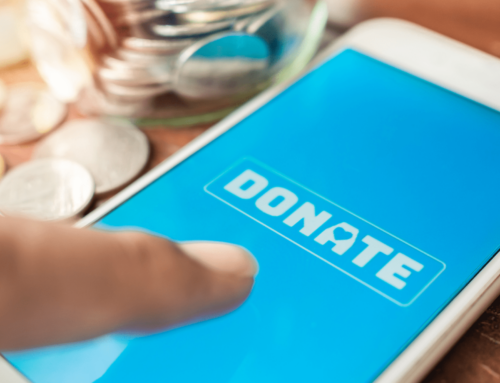Successful fundraising long-term for any nonprofit involves much more than just one event.
If you want your organization growing and thriving for the long haul, consider the following checklist before jumping into planning your next nonprofit fundraising campaign.
Take Time to Re-Energize With Your Mission Statement
Remember your nonprofit’s mission statement? That heart-felt, passionate reason you started your organization in the first place? Maybe you talk about your mission statement every day with your team, or maybe it’s been a while. Either way, it may be worth it to take time to sit down with key team members and dig back into the mission together. Why are we here?
Why is what we do so important? Are we accomplishing what we originally set out to do? As you inspire each other anew with your enthusiasm for the mission at hand, you’ll breathe fresh energy and motivation into your team members for the hard work of fundraising that lies ahead.
Your donors need to hear your mission again too, especially as you begin to reach out for donations. Are there any specific stories you can share from this past year of people who were helped by your organization? Stories will help your donors visualize themselves as part of the mission. Outlining your mission statement with a fresh perspective will set you up with the language you need to remind donors why your organization exists, why your mission matters, and why it’s important that they keep giving.
The bottom line: Everything you do as a nonprofit flows out of your mission statement, so take the time to dig back in and re-outline it if needed. Your team will work with a renewed energy and your donors will feel confident that they should stick with you, ultimately setting your organization up for success with your next fundraiser.
Update Your Supporter/Donor Information
Most likely, you have a good idea who your audience is. You’ve already done the work of identifying which individuals or groups of people need the services your nonprofit provides. But, if it’s been awhile since you’ve taken a look at who is actually interacting with your organization on a regular basis (volunteering, making donations, participating in events, etc.) it may be time to update your supporter information.
If you haven’t already, write out profiles for some of the key individuals who are consistently engaged with your organization. These profiles can be as vague or as detailed as possible, but really, the more information the better. Going beyond demographics, your profile should answer questions like: Historically, in what ways has this person been involved with my organization? What are their specific reasons for giving my organization their support? How much and how often do they give? What are their other interests? When completed, you’ll begin to notice in broad strokes the traits/interests/issues that your supporters hold in common, and you may even identify some target audiences you may not be reaching.
It’s important that your profiles include financial information as well, so pay attention to trends that indicate where your fundraising revenue has come from in the past. Holistically, look at the ways your organization receives and spends money. Is there room for improvement? Were there activities from the past year that were ineffective? You may recognize new areas where you can cut expenses. You may need to hire a new staff member to better rise to the challenge of accomplishing a goal. Whatever step your nonprofit takes next should be informed by your donor/supporter information from past years.
The bottom line: Make sure you have the most accurate, up-to-date view of who supports your nonprofit and how much they give. This will ensure that your organization has a strong foundation to work from as you move forward in planning your next fundraiser.
Optimize Your Communication Strategies
Are you communicating with your followers on social media in the most effective way possible? There may be different or better points of connection your nonprofit can be making with your current audience to grow donations or increase overall engagement. There are millions of nonprofits worldwide, so your donors need to be reminded why they should continue to choose yours.
Optimize your social media management through the way you communicate with your current followers/subscribers and you will nurture those important relationships. The best way to do this is by using the most current nonprofit donor statistics available. Your supporter profiles (from the previous section) have the demographic information that show you who your audience is. Now you are able to use donor statistics to see if there are better ways to reach your audience. Take these compelling statistics for example:
- The majority of donors worldwide are between the ages of 56-74
- Regular email communication is the communication method most likely to inspire repeat donations (social media communication came in second)
- Of those inspired by social media to donate, Facebook Fundraising Tools were the most utilized in 2020, with 40% of donors (in Canada and the US) giving through the platform
- 92% of all donors worldwide said that nonprofit organizations need to invest more financial resources in digital communications in order to stay relevant
Sending an annual report via email is a great example of optimizing communication to build trust with your donors. Donors want to make sure their money is being used wisely, so transparency of this kind is key. Consider how you can use other communication platforms to let donors in on more that is going on within your organization – day-to-day activities of your staff and volunteers, your successes and failures, your plans for the future – the more your donors engage with you, the more likely they will stick around.
The bottom line: Don’t gloss over statistics, let them guide you. The data is there to provide your nonprofit with the clearest picture of donor trends around the world, including the donors you are trying to connect with. Translating that raw data into helpful communication strategies for your organization can take some time and manpower, but it’s worth it. In the end, you will be able to lay a more effective communication groundwork for your organization’s next fundraising campaign.
Invest In Prospect Research
Before a public fundraiser can begin, any successful nonprofit has already done a fair amount of prospect research. Prospect or donor research is the process of identifying potential major gifts donors to your nonprofit. Different from fundraising, which most often leverages public support for donations, prospect research seeks to leverage key connections to wealthy, philanthropic individuals who connect with your organization’s cause. Doing the research and creating an effective donor prospect list can help secure major gifts for your organization and more. Think: planned gifts, annual giving, corporate giving, alumni giving, and donor-advised funds. As you go through the process of identifying new potential donors, make sure to include these 3 key factors when building your list:
Wealth Markers – What is this person or organization’s financial capacity to give? Do they own stock or real estate? Do they have other business affiliations?
Philanthropic Indicators – What is the likelihood that they will give? Are they already involved in other philanthropic activities? The past is the most accurate predictor of the future here, as individuals are more likely to give if they have a history of giving to your organization or other organizations like yours.
Activities and Interests – What other hobbies or interests do they spend time on? Do they make any political contributions? Finding people whose activities and interests are in line with your mission can enable you to have multiple points of connection with a donor as you reach out for support.
Though the process is challenging, most nonprofits know that prospect research is an essential part of sustaining operations long-term. If you decide to DIY the research, be sure to invest in a prospect research database that will put all the data you need right at your fingertips. If your nonprofit simply doesn’t have the resources to do the research in house, consider hiring a professional consultant to lead the charge.
The bottom line: Prospect research can significantly enhance your nonprofit’s fundraising capabilities by identifying and connecting with philanthropic individuals who have a personal interest in your organization and also the financial capacity to give big.
Clean Up Your Web Pages
Once fundraising begins, prospective donors will start to visit your site to see what your nonprofit is all about, and hopefully make a donation. Imagine missing out on a potential donor because they simply can’t navigate your website! A good rule of thumb to use when determining your website’s usability is to have someone who has never used your site before look at it for you. If they can’t find what they need in 3 seconds, your website may need some fine-tuning. Our guest poster Monika Jansen calls this the “Grandma Test“.
Also, If your website isn’t optimized for mobile devices, it can irritate donors and reduce your ranking in search engines. Many donors will access your page from their smartphones, so make sure it’s accessible and easy to use.
The most important page on your website – your online donation form – should be the easiest of all for donors to navigate. Be sure to:
- Make it brief. Only ask for pertinent details. Try to prevent donors from having to enter the same data more than once. For example, if a donor’s billing address and mailing address are the same, you can offer a checkbox so they don’t have to enter their address twice.
- Suggest donation amounts. Giving donors a concrete suggestion makes the checkout process smoother, and can also encourage donors to make a slightly larger gift than they may have otherwise. You can even add descriptions to each amount, stating what kind of impact their donation will make. For example, a gift of $100 could equal 30 toys to children in need.
- Reflect your nonprofit’s unique brand. Brand your online donation form with your fundraising tools. You can also use your branding to fully customize donation receipts, thank you emails, and donor summaries, which will facilitate a cohesive donation process that connects a donor to your nonprofit’s work at every step. Your online donation form should do more than just take someone’s financial information—it should reinforce their positive feelings toward your organization.
The bottom line: To keep your nonprofit from missing out on any potential donations, your website should be easy to navigate on any device. Your online donation form should be user-friendly and also serve to inspire the donor to give and engage at their maximum potential.
Make Sure Your Team Is Ready
Down to the lowest-paid intern, communicate clearly so that each member of your team knows what’s expected of them during your fundraising campaign.
Conduct interviews with key players within your nonprofit and make sure everyone is on the same page. It may sound silly, but sometimes the basics can get lost in the shuffle. Make sure they know the answers to these questions: What is our fundraising campaign trying to achieve? What specifically will the donations be funding? How much money do we want to raise? How long will this campaign take, realistically? Assess the preparedness and enthusiasm of your team as a whole. Do they understand their specific role? Are they excited to get on board for the duration of the fundraiser (however long that is)? If you’re getting a lot of blank stares or empty silences in your meetings, there may be a disconnect that you need to address. Consider conducting a fundraising feasibility study to help with this.
Once expectations are clear, it’s time to delegate. For each activity your nonprofit needs to accomplish in preparation for your fundraiser, identify the person responsible for its execution and set a timeline, or deadline by which it needs to be done. Create a master calendar to keep everyone on the same page.
The bottom line: Before fundraising begins, everyone on your team from top to bottom needs to be clear on what their roles are and what your nonprofit is trying to achieve. Interview your employees and seek honest answers. Address any gaps in information and clarify roles for each person involved. Fundraising works best when everyone is firing on all cylinders!
Say Thank You
Before beginning another fundraising campaign, it’s important to thank your donors for the ways they have contributed to your nonprofit up until now. This is an essential part of donor stewardship, which not only engages with the donor on a personal level, but makes them feel good about their gift. A donor who feels positive about their experience with your organization and about their impact will be more likely to recommend you to their family and friends, and will more likely become a recurring donor.
There are many ways you can say “Thank you” to your donors and supporters:
- Personalized email or social media outreach
- Personal phone calls
- Handwritten cards
- A free donor appreciation event
- An annual report of funds raised and details of where the money went
The bottom line: Expressing thanks is an essential part of nurturing donor relationships. The gratitude that is shared will hopefully go both ways and last a lifetime!
Preparation is everything when it comes to fundraising, so do your due diligence as you go through this checklist. Putting in the work will pay off for your nonprofit in the long-run, and help you find success from fundraiser to fundraiser.
If you are interested in more great tips for online fundraising, check out this expert fundraising advice from our friends at Donorbox.





